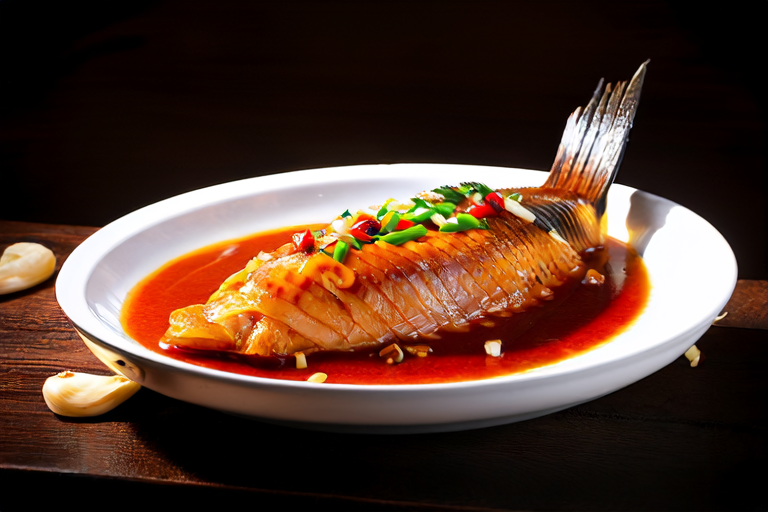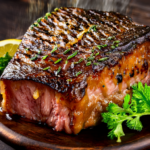Savoring the Essence: A Traditional Zhejiang Style Braised Fish Delight
Introduction
In the vast culinary landscape of China, Zhejiang cuisine stands out for its delicate flavors and harmonious balance of tastes. Known for its emphasis on freshness and subtlety, this regional cuisine offers a unique dining experience that is both refined and comforting. Among the many dishes that exemplify the essence of Zhejiang cooking, braised fish is particularly noteworthy. This dish not only highlights the region’s commitment to preserving the natural flavors of ingredients but also showcases the skillful use of braising techniques to create a deeply flavorful yet tender dish.
This recipe delves into the traditional method of preparing Zhejiang-style braised fish, offering insights into the selection of fresh ingredients, the art of seasoning, and the careful execution of each step. By following this guide, you will be able to recreate the authentic taste of Zhejiang in your own kitchen, savoring every bite of this delightful dish.
Ingredients
To prepare a truly authentic Zhejiang-style braised fish, it is crucial to select high-quality ingredients that reflect the freshness and purity of the region’s culinary traditions. Here are the key components needed for this dish:
- Fresh river fish (such as grass carp or catfish), weighing about 1-1.5 kg
- Scallions, cut into segments
- Ginger, thinly sliced
- Garlic, minced
- Shaoxing rice wine (also known as Shaoxing wine)
- Dark soy sauce
- Sugar
- Chicken stock or water
- Vegetable oil for frying
- Spring onions, chopped for garnish
- Peanuts, roasted and crushed for garnish
- Green onions, chopped for garnish
It is important to note that the quality of these ingredients directly influences the final outcome. Opt for fresh, wild-caught fish to ensure the best flavor and texture. Similarly, using aged Shaoxing rice wine and top-grade dark soy sauce can elevate the dish, providing a more complex and satisfying taste profile.
Preparation
The preparation of Zhejiang-style braised fish involves several meticulous steps that require attention to detail and patience. Each step contributes to the dish’s ultimate flavor and texture, ensuring a harmonious blend of flavors that captivates the palate.
- Cleaning and Preparing the Fish: Begin by thoroughly cleaning the fish under cold running water. Remove any scales, internal organs, and gills. Pat the fish dry with paper towels and make shallow cuts along the sides to allow the marinade to penetrate better.
- Marinade: In a small bowl, mix together Shaoxing rice wine, dark soy sauce, sugar, and a pinch of salt. Rub this mixture all over the fish, making sure to coat it evenly. Let the fish marinate for at least 30 minutes to allow the flavors to infuse.
- Browning the Fish: Heat a large pan or wok over medium-high heat and add a generous amount of vegetable oil. Once the oil is hot, carefully place the fish in the pan, skin-side down. Fry the fish until the skin becomes crispy and golden brown, then flip it over and fry the other side. This step not only adds a delightful texture but also helps lock in the flavors during the subsequent braising process.
- Braising: After browning the fish, transfer it to a deep, heatproof dish. In the same pan, sauté scallions, ginger, and garlic until fragrant. Pour in chicken stock or water, adding enough to cover half of the fish. Bring the liquid to a simmer, then carefully place the fish back into the pan. Cover the pan with a lid and let it simmer gently for approximately 20-25 minutes. During this time, the fish absorbs the flavors from the braising liquid, becoming tender and succulent.
- Finishing Touches: Once the fish is fully cooked, remove it from the pan and set aside. Reduce the braising liquid to a thick, glossy sauce by simmering it over medium heat for a few more minutes. Stir in a little more dark soy sauce if needed to deepen the color. Pour this rich sauce over the fish, garnishing it with chopped spring onions, roasted peanuts, and green onions. Serve immediately to enjoy the dish at its peak.
Cooking Tips
Preparing Zhejiang-style braised fish requires not only precise techniques but also a keen understanding of the nuances involved in each step. Here are some valuable tips to help you achieve the perfect result:
- Choosing the Right Fish: While grass carp is commonly used in this dish, other types of freshwater fish such as catfish or crucian carp can also be excellent choices. The key is to select a firm-textured fish that holds its shape well during cooking.
- Marination Time: Allowing the fish to marinate for at least 30 minutes ensures that the flavors penetrate deeply into the flesh. However, longer marination times (up to an hour) can enhance the depth of flavor even further.
- Oil Temperature: When frying the fish, ensure the oil is sufficiently hot before placing the fish in the pan. This prevents the fish from absorbing excess oil and ensures a crispy exterior.
- Braising Technique: Simmering the fish gently rather than boiling it helps maintain its tenderness. Avoid lifting the lid frequently during the braising process to prevent evaporation, which could affect the concentration of the sauce.
- Sauce Consistency: Achieving the right consistency for the braising sauce is crucial. It should be thick and glossy, clinging to the fish without being too watery. Adjust the amount of liquid added to the pan based on the size of the fish and the desired thickness of the sauce.
Serving Suggestions
Zhejiang-style braised fish is traditionally served as part of a larger meal, often accompanied by steamed rice, stir-fried vegetables, and perhaps a light soup. The rich, savory flavors of the fish complement these simple accompaniments perfectly, creating a balanced and satisfying dining experience.
For those who prefer a more substantial meal, consider pairing the fish with steamed buns or dumplings. These soft, doughy accompaniments absorb the flavorful sauce, enhancing the overall dining experience. Additionally, a side of pickled vegetables can provide a refreshing contrast to the richness of the fish, balancing the flavors beautifully.
When serving the dish, present the fish attractively on a platter, garnished with fresh herbs and nuts. The visual appeal of the dish enhances the dining experience, inviting guests to appreciate both the aesthetics and the flavors.
Nutritional Information
Zhejiang-style braised fish is not only a feast for the senses but also a nutritious dish. Here’s a breakdown of its nutritional content per serving:
| Component | Amount | Calories | Protein | Fat | Carbohydrates |
|---|---|---|---|---|---|
| Per Serving | 100g | 180 kcal | 22g | 6g | 4g |
This dish is rich in protein, which is essential for muscle repair and growth. It also provides healthy fats that support heart health and brain function. The low carbohydrate content makes it suitable for those watching their sugar intake. However, due to the presence of soy sauce and sugar, individuals with specific dietary restrictions should consult with a healthcare provider before consuming.
Conclusion
Zhejiang-style braised fish is a testament to the culinary artistry and cultural heritage of Zhejiang province. Its combination of tender fish, aromatic spices, and rich braising sauce creates a dish that is both comforting and sophisticated. By following this detailed recipe and tips, you can bring the essence of Zhejiang cuisine into your home, savoring each bite of this delightful dish. Whether enjoyed as part of a family dinner or a special occasion, Zhejiang-style braised fish promises an unforgettable dining experience that celebrates the beauty of simplicity and tradition.


